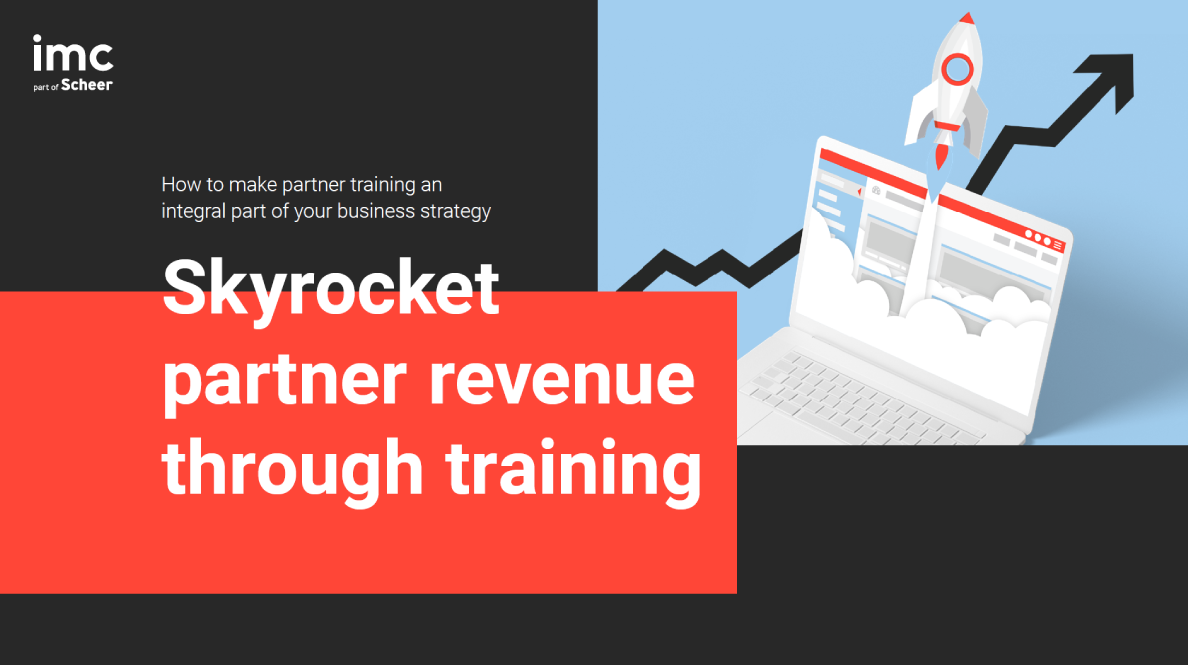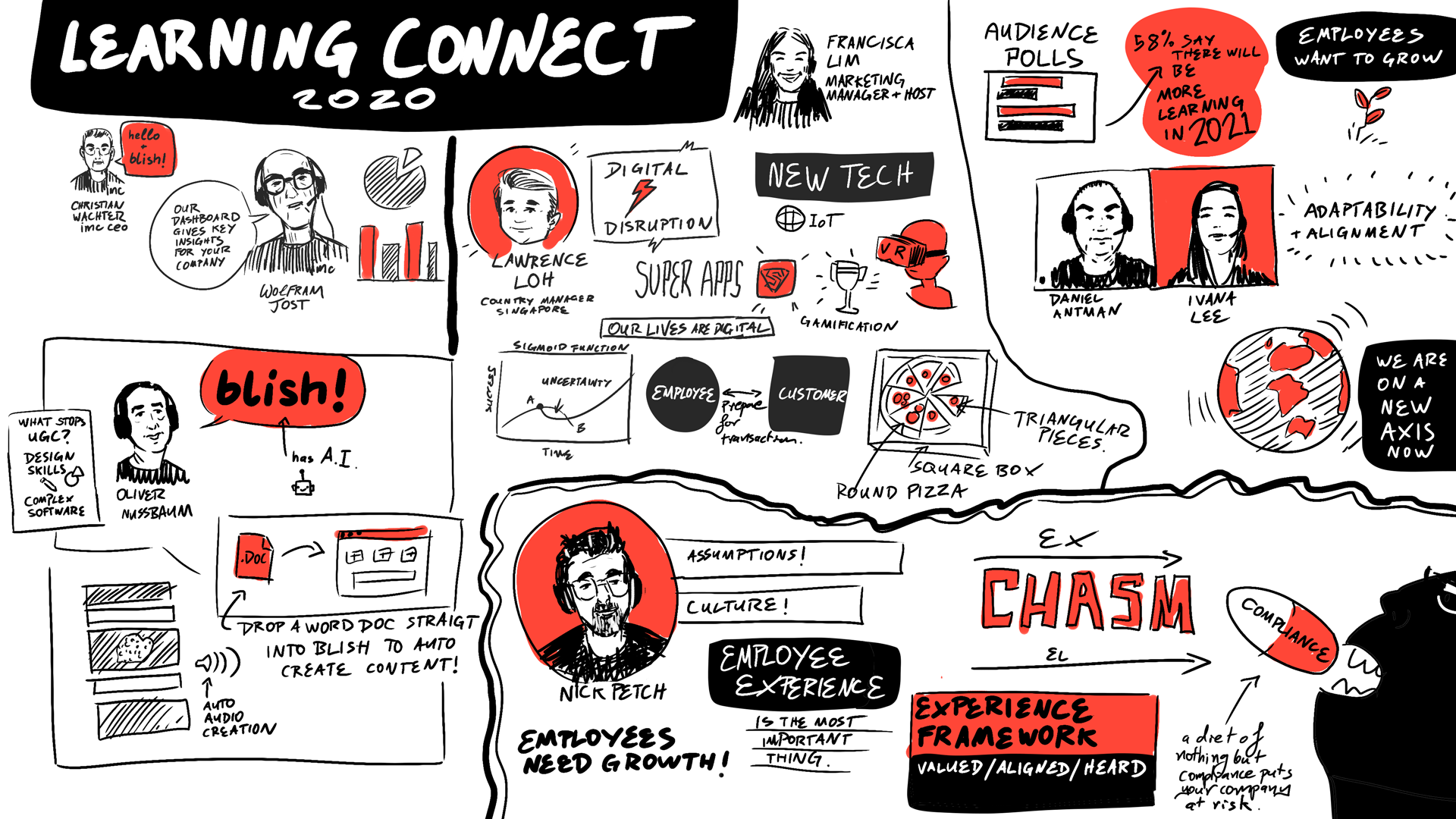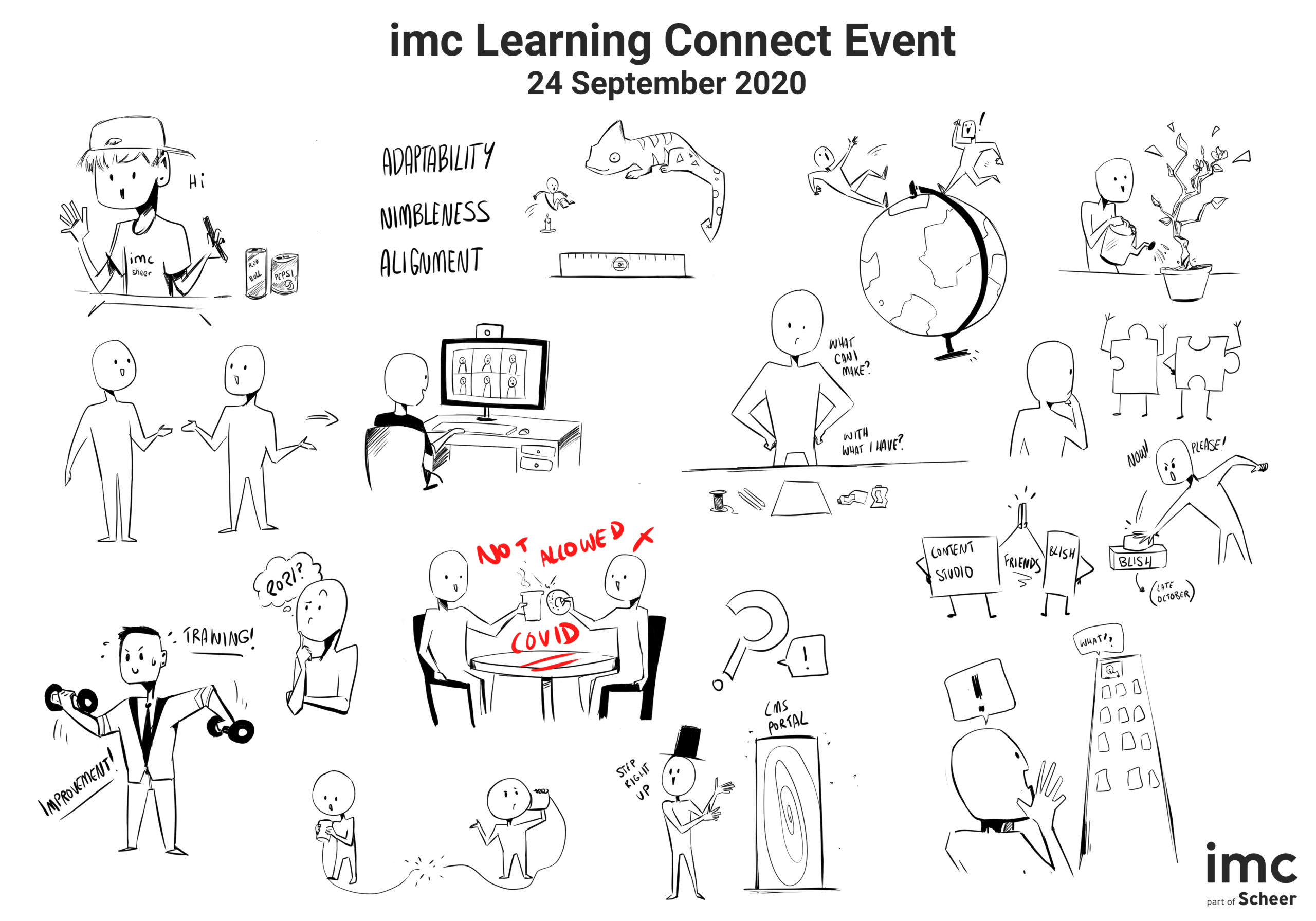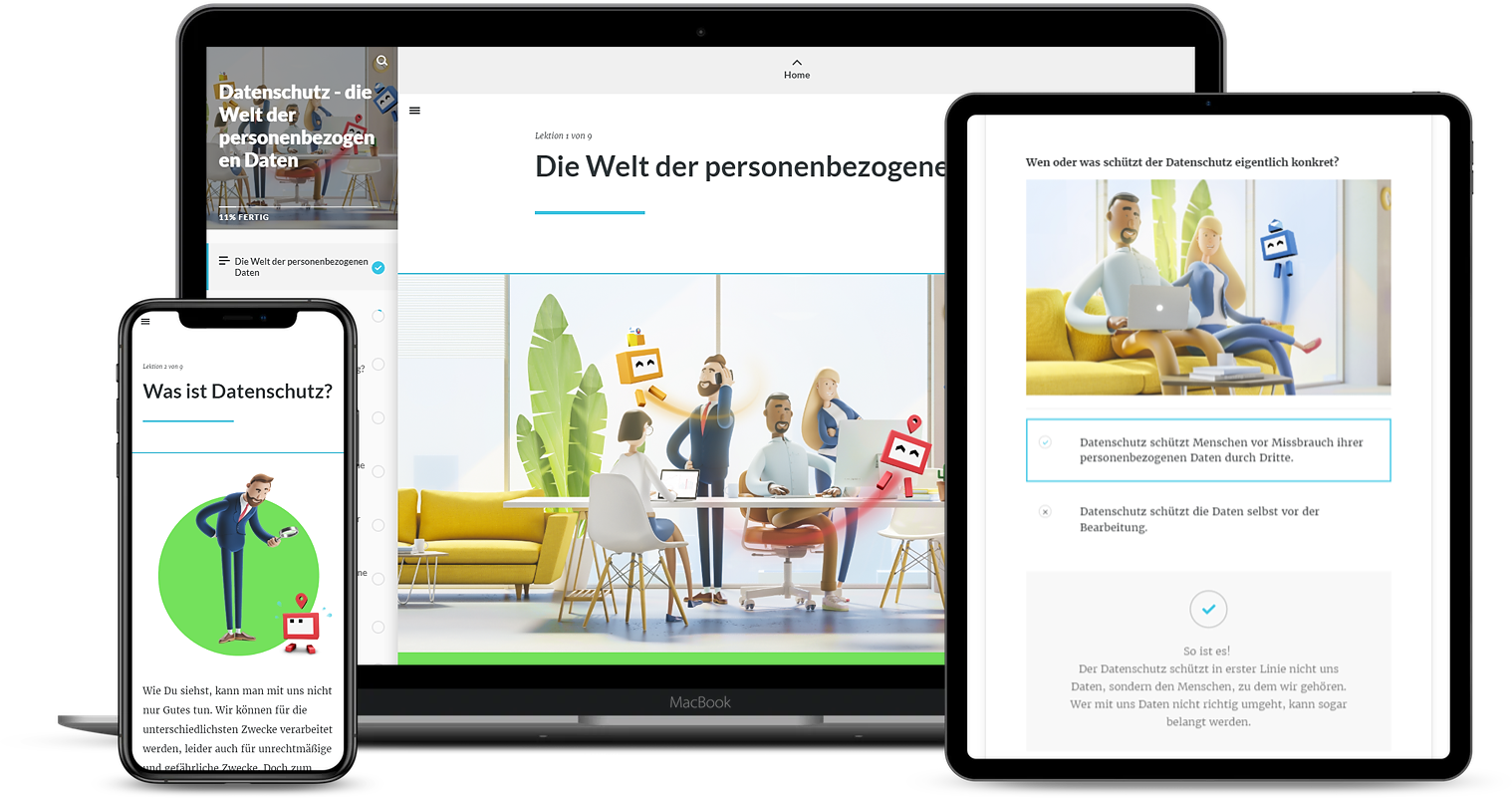
Multi-tenancy LMS solutions
Here we look at multi-tenancy LMS solutions, including a definition, the types of organisations that leverage them, and how imc can help clients to maximise their effectiveness to deliver training across diverse groups of learners.
What is multi-tenancy?
In the field of software, the term multi-tenancy refers to a single application shared by multiple user groups who each experience their own, individualised working environment.
Each ‘tenant’ is a group of users that shares certain common features with other tenants, but that may have certain design elements, layouts and privileges that are unique to their group.
A useful analogy is a block of flats. The building has a shared entrance, lifts and stairways, but each tenant has their own, self-contained flat. The tenant can choose their own appliances, furniture and interior design / decor.
What is a multi-tenancy LMS?
A multi-tenancy LMS is a single learning management system instance that serves various learner groups with differing training needs. This may take a range of potential forms, depending on your organisational needs, and could include:
- Different departments across a large organisation - for example, you may have separate learning environments for Sales and Manufacturing teams because their training needs are so different
- Local offices across different locations - even multiple countries, allowing localisation or translation of training content
- External partners - you can create tailored learning platforms for groups outside your own organisation, including suppliers, distributors and channel sales partners. This type of partner training is known as Extended Enterprise Learning.
- A specialist training company, delivering any number of client-branded learning environments, or even using ecommerce to sell courses online.
Your organisation-wide L&D team can control what content and features are rolled out to all tenants, and what is managed within each individual group.

Benefits of a multi-tenant LMS
The benefits of multi-tenant LMS vs a standard learning platform are numerous, but the overarching themes are efficiency and flexibility. Here are some of the elements that L&D managers and business leaders are looking to achieve when they choose multi-tenancy:
Cost reduction
When you need to segment the learning experience across departments, it has been common in the past for each one to have their own LMS. A multi-tenancy LMS offers economies of scale and allows each department to share the cost of the core platform and any common content, features, and system upgrades.
Knowledge and resource sharing
When every department operates in completely distinct silos, there is less functionality and visibility between them to facilitate resource and knowledge sharing. If something works for / is created within one department, a multi-tenant LMS makes it easy for the central administration team to share it across more or all departments.
Departmental and centralised analytics
With multi-tenancy, you can drill into course and learner analytics at the departmental and group-wide level. This can help you to identify and address training needs and weaknesses among certain types of user. It also helps you avoid overall learner data getting skewed by one or two outlier groups.
Speed of implementation
When something changes that affects several or all of your teams, it can be much faster to roll out from central management if they can influence all of those learning management systems in one hit.
For example, new legislation like GDPR could affect all departments, so managing relevant training from a central location, while allowing it to be customised if and where needed, can greatly quicken roll out.
Brandability
Whatever the training needs of a certain learner cohort, a multi-brand LMS enables each group to make their LMS feel like home.
Whether it’s for external clients to have their own company branding or internal teams who just want to customise it to their preferred style, a branded LMS can enhance user acceptance and in turn, improve compliance, engagement and learning outcomes.

Why an imc learning management system?
Founded in Germany, imc is one of the world’s leading elearning and LMS providers, with offices and clients across the globe. With a diverse, international presence, we understand the needs of companies that need to train dispersed and diverse audiences. We combine some of the sharpest technology minds with deep experience within L&D.
imc is trusted by well-known brands, including Vodafone, Deloitte, Sky, Daimler, BASF and many more to deliver on their elearning needs.
Many of our clients benefit from our ability to create and deliver powerful multi-tenancy solutions that work equally well in multiple languages, offline or online, on desktop or mobile.
With a huge, unique array of integrations made possible via APIs, we can help you to create a learning ecosystem that plays nicely with your existing training, HR, sales and other business systems. This allows you to plug seamlessly into 3rd party tools like Workday, Adobe, SAP, YouTube, Salesforce, and even ecommerce gateways like PayPal and Shopify if you want to sell elearning courses.
Whatever your internal staff or external partner training needs, imc can help you to create a multi-tenancy LMS solution to power your current and future learning.

How to train external audiences
It’s no secret that your internal team is your organisation’s greatest asset. However, you should bear in mind that it isn’t your only asset.

Business growth through L&D
Data suggests that when organisations spend USD 1,500 per employee per year on learning, they achieve improvements in profit margins of around 24%.
Contact
As imc has over 20 years of experience working with 1,200+ organisations globally, we can confidently say we have seen and solved many business challenges just like the ones you are facing today.
That’s why we would love to learn more about your situation and to give you some tailored, expert advice to solve the obstacles that you are facing.
Feel free to connect with Tracey for a free consultation call.


When watching a Play or an Opera, the greatest attention is usually only on those who are directly on stage. On many Company Websites or Brochures, it is a similar situation. If real employees are visible at all, they are usually from marketing or sales for example.
However, as we know, it is not only those at the front that contribute to the success of any production or product, but there are also many people involved who are unseen and work very hard behind the curtains.
In a software company, Developers may be the first to come to mind, which is certainly not wrong. In my experience, one special department which has one of the most important tasks of all, is often overlooked, that is the “The Product Management Team”.
Here, important decisions about the direction in which the software will be developed and what requirements it must meet, are made. That is why I was excited to talk to Lia Ghita from Sibiu, who is one of the Product Managers responsible for imc's main product, the Learning Management System (LMS) imc Learning Suite.

Lia Ghita
Job | Product Manager
Working in | Sibiu, Romania
Worked at imc since | 2014
Super power | pro-activness & problem-solving
Favourite food | Mam's pasta with tomatos and mushrooms

Hi Lia, thanks for joining! So, first of all: How would you describe your job to a child?
Maybe not to a five-year-old but rather to an older child who ever saw an orchestra perform, I could describe my role as something like an orchestra conductor. The conductor is the one who helps everyone in the orchestra to reach the tone, the amplitude of the sound and tells the different instruments when to play.
In a way, a product manager’s role is similar, as we coordinate, prioritise, and balance the tasks and the different roles involved in the software development process.

How did you get into Product Management?
I would somehow call it a series of fortunate events that led me here. Although I studied computer science in high school, I wanted to try a completely different path and ventured in studying law.
However, halfway through my studies I realised that I would not be happy being a Lawyer so after graduating I started working as a Customer Service Representative in a multinational company. As part of that role, undertaking technical support among other things, I started to come closer again to the computer science domain.
I always think about it as transitioning from one type of code to another...
I first started with imc as part of the Quality Assurance Team and that experience helped me form an understanding about LMS use cases and our customers’ workflows. Not long after, I was given the opportunity to work with a dedicated team of developers to enhance our native apps, which opened the door to the universe of Product Management.
So how would you describe a typical day?
I think the easiest way to explain this, is to take you a little through the steps in Product Management, because there is no such thing as a typical day.
We always start from a business need, meaning we identify a direction in which we want to go with the product. Based on that, we identify the concrete use cases and create a roadmap. In that phase we are also in close contact to our customers and based on their requirements, we plan the next release.
Once the scope for an innovation package is agreed, we prepare the functional specifications and work closely with our Design Team to prepare workflow mock-ups. We groom with our development team to identify solutions and have them estimated and then we proceed with the implementation, in an Agile way.
We usually close an innovation pack with an internal knowledge transfer and documentation of the recently implemented enhancements.
Throughout all these phases, we are in contact with all the roles within imc and our customers, which can make it a very diverse experience from one day to the other.

Which character traits are particularly important for your job?
As a Product Manager, you must be a very pro-active person and you must be able to organise yourself. In my role you do not get a set of tasks and someone tells you to do these or that.
You must know the overall goal and work towards it. You must be able to prioritise and to organise yourself, your team and the time accordingly. The mindset is also important. The mindset that tells you: “Just do it, find a solution, get out there and solve the problem!”
Subsequently, what is your most valuable skill?
I would say problem-solving skills and the joy I find in the process of figuring out the solution for a complex problem. This is one trait that brought me closer to the development part of the process and to the many debugging sessions together with the developers to try and find solutions together.

What is the strangest thing that you have ever experienced in your job?
The example that comes to my mind was not so much strange but different and unique.
Recently we had a workshop with a customer from Italy and the customer was not so fluent in English, although they could understand it. I understand Italian, as it’s very similar to my native language Romanian, but I can’t speak it. So finally, we ended up with me speaking English and the customer speaking Italian – and it worked!
What is special about working at imc compared with other companies?
Well, I’ve only worked for one other company so far. There I also changed different roles and learned a lot, but here is a completely new level.
I really enjoy getting to know different aspects of running the E-Learning business and I also like the size of the company, it’s not too big or too small. You still have the chance to get in contact with other departments and colleagues from different roles.
I think it is important to get out of the comfort zone and to extend it. At imc you have the chance to experience that every day.
What’s the most important thing you’ve learnt since working here?
I have learned that it’s never too late to learn new things. Since joining imc I had the opportunity to explore once again programming, which even motivated me to pursue my second bachelor’s degree, this time in Computer Science.

What motivates you?
Reactions like we recently received in our knowledge transfer! This is an internal format where we introduce new releases to all our colleagues from imc.
In the last knowledge transfer, when we demonstrated the highlights of the new release, our colleagues from all over the world were so impressed and happy and wrote things like “Wow, this is such a great feature”, or “looks awesome, great job”. It is such a good feeling to see your work being appreciated after you put in so much effort.
Do you have a professional or personal role-model?
Since I started in Product Management and even imc, it was Daniel Dahrendorf who I worked with closely. I appreciate his calm and patience. He can transfer information in a very relaxed manner. This is something I admire as I sometimes struggle a little to stay calm, but I try to work on that and take him as an example.
Another very important question: Chips or chocolate?
Chips. I don’t like sweet things most of the time.

And finally: Your team in one sentence?
We're united, supportive, and share a good energy, it’s just a pleasure to work together!
Thank you so much Lia for the great interview and all the best for the future!

Software developers are also just human
Software developers are also just human, like Sim, who works for imc in Melbourne. We talked about her daily work, cultural differences and personal role models.

More than a notorious nagger
Only notorious naggers work in quality assurance? Not at all! QA specialist Ioana explains what icebergs have to do with her daily work, how she actually got to her job and what you need for it.
Would you like to know more about imc as an employer? Then take a look at our career section, maybe there is a suitable position for you.
We are also always happy to receive unsolicited applications!

Contact person
I have been working in the Marketing & Communication Team at imc since March 2019.
Communication, creating unique content and social media are my passion.
"One can not not communicate" - Paul Watzlawik.
To explain complex content in an understandable way and thus make the topic of e-Learning accessible to everyone is an exciting challenge every day.
Privately I love to read, play poker and travel a lot.
I am always happy to receive feedback or suggestions.

Growing your business through partner training
It’s no secret that your internal team is your organisation’s greatest asset. However, you should bear in mind that it isn’t your only asset.
An organisation doesn’t operate in isolation. Its growth and success are also dependant on its network of partner relationships.
Your partners’ success is your success and in order for your partners to be successful, it’s your job to support them in every way you can. Training plays a pivotal role in this. If your organisation trains its network of partners, you empower the people outside of your organisation to contribute to your business goals.
It results in:
- more trained resources
- more efficient collaborative processes
- more revenue
Plus, it turns your partners into advocates and your advocates into your most ardent sales representatives.
In short, it will grow your business.

A massive opportunity, especially now
In these unprecedented times, many organisations are cautious when it comes to future plans. However, many others use this moment to accelerate their organisation’s digital transition and see new business opportunities.
“With massive disruption comes massive opportunity. I've seen many organisations rethinking their business model, with digital learning becoming an enabler to help them extend reach, drive new channels or implement new business approaches”, says Russell Donders, imc’s Director of International Markets. “(Digital) partner training is definitely one of these opportunities to grow businesses in challenging times.”
Partner training in an extended enterprise
The approach of empowering partners through training, is often referred to as Partner Training or Extended Enterprise Training.
But what is an extended enterprise?
An extended enterprise acknowledges that its growth and success is (partly) dependant on its network of partners. Therefore, it invests in its partner relationships and strives for optimal communication and collaboration with these partners, ultimately, to achieve shared business goals.
Aligning and training are essential in leveraging the collaborative relationship of all the partners involved in this extended enterprise.
And that is not just sales partners. Customers, members or even the general public can also be valuable partners who can contribute to your business goals. Keep that in mind when we are talking about partners; among all those external audiences connected to your organisation, there might be more potential partners than you think.
Competitive advantage
As most organisations fail to effectively empower external audiences, partner training (or extended enterprise training) will create a strong competitive advantage in your target market.
Ultimately, unlocking all that extra market potential will result in increased earning potential.
Or as our imc board member, Wolfram Jost, puts it: “a learning curve leads to an earning curve.”

Wolfram Jost, imc board member
What about not-for-profit organisations?
The concept of an extended enterprise sounds perfect for businesses, but what about not-for-profit organisations? Such entities often don’t see themselves as businesses or any form of commercial enterprise, for that matter.
Thankfully, the principles and ideas of extended enterprises for commercial entities also work well for non-profit organisations.
Remember that the word ‘partner’ can refer to all kinds of external audiences. If you run a not-for-profit organisation, the extended enterprise concept and the idea of training the partner network can also apply to e.g. your members or volunteers. Educating those external audiences will help your not-for-profit organisation achieve its goals, even if these goals are not primarily commercial.
How to get started with partner training
The concept of partner training sounds good in theory. But, how does it work in practice?
You may be worried about the logistics, the complexity or data security, data privacy, and compliance. All these thoughts conjure up many red flags in your mind and cause alarm bells to ring.
In other words, the mere thought of partner training is causing you to break out in a sweat.
But what if setting up a training environment that caters to all your needs isn’t as complicated or scary as it sounds?
The most important takeaway is: do not try to reinvent the wheel.
This is how you make partner training an integral part of your business strategy

In our whitepaper Skyrocket partner revenue through training we discuss the topics you should consider when incorporating partner training in your business strategy and we share practical tips and insights about how to get started.
Contact
As imc has over 20 years of experience working with 1,200+ organisations globally, we can confidently say we have seen and solved many business challenges just like the ones you are facing today.
That’s why we would love to learn more about your situation and to give you some tailored, expert advice to solve the obstacles that you are facing.
Feel free to connect with Ailbhe for a free consultation call.


Corporate Learning 2021:
Looking to the future – right now
2020 was an exceptional year – shaped by a global pandemic, it will undoubtedly remain in our collective memory for a very long time to come.
We have talked a great deal about what this crisis means for digitalisation. Is it a driver or an inhibitor? Where are the hidden champions? Do we have an appetite for digital fast food, or do we hunger for slow food?
Of course, not every company was prepared to grab the bull by the horns, but digitalisation has been shown to ensure a company's survival while opening up new possibilities as well. In addition to new markets, business models and target groups, professional development has certainly taken on a key role this year.
These are exciting times for Learning and Development Professionals, as in-person training sessions, which had generally been the norm up until the crisis, now present new challenges for organisations. It's time to rethink professional development! We are experiencing an unforeseen demand for online formats and learning platforms, as well as a need to create hybrid formats; for example, social learning has suddenly transcended the limits of likes and comments.
In this series of articles, however, we will not be looking back but rather setting our sights on the future. While imc experts from around the world share their experiences from last year in a four-part special feature, they are primarily looking forward to new topics, trends and opportunities.
This special feature is meant to provide encouragement as well as ideas and impulses for the coming year. Nick Spielkamp, Head of Marketing and Sales at imc Switzerland will kick the series off with Part 1.

Nick Spielkamp, imc
In the upcoming year, digital training initiatives in Switzerland will focus strongly on actual business output. The current crisis will continue to be a driver for digital learning in 2021, but the effect of all training measures on the enabling of employees will be monitored even more closely, so that training budgets can be used accordingly.
So I see a strong shift from a pure training focus to a strong performance focus. In order to be able to substantiate the effects on the optimization of work results, the consolidation of training and business data in the form of Learning Analytics analyses will play a central role in the coming year.
Learning Analytics data not only provides evidence of the effectiveness of training measures, but also allows for targeted intervention in training to further optimize it and ultimately make employees better at what they do.
In addition to the continuous sharpening of digital training measures in terms of business output, I see a strong decentralization of the design and production of digital training content in the coming year. The Corona crisis has further reinforced the trend that more and more learning content must be digitized in the shortest possible time.
This cannot be achieved by the professional learning and development departments in the companies alone, which is why the technical experts themselves are increasingly assuming responsibility at this point.
However, these know-how carriers must be enabled accordingly in order to create didactically and visually high-quality training courses for various output formats at a reasonable cost. This is exactly where new types of rapid authoring solutions will play an important role, supporting the subject matter experts with artificial intelligence in the efficient production of digital learning content.
Contact
I’ve been a member of the imc crew since February 2019. My multi-faceted tasks always keep me on the go. In addition to my work on corporate brand, marketing and communication strategies and employer branding, I also delve into the operational side.
I have a passion for networks and communities. That is why I represent the brand ambassador programme in the editorial team. I am also actively involved in the SCHULEWIRTSCHAFT (School-Business) network.
Privately, my big passions are travelling, Disney and interior design.


Why the gains from a learning management system outweigh its costs
...and how you can prove that with a
business case

We have no money. Who is meant to take care of it? And what’s the point anyway? These are some of the most common arguments and concerns brought forward when the topic of learning management systems (LMS) comes up. However, many decision-makers miss that the payback period for such an investment is incredibly short – provided the system is implemented and utilised in a consistent and meaningful way.
It’s easy to show that this is not just an empty marketing claim when basing calculations on a business case. You run through a scenario, examining strategic, economic and managerial, as well as process-based aspects. We spoke to Sales Manager Svenja Kreten who has created business cases many times over.

Svenja Kreten, Sales Manager at imc
She is convinced: “For most clients, a learning management system pays for itself within a year. I can demonstrate that using figures validated together with the companies in question.”
In our FAQ, we summarised in easy terms how she obtains those figures, what a meaningful business case calculation should look like and what factors to include.
What is a business case?
A business case is useful for evaluating the investment in an LMS. It helps to illustrate costs, benefits, risks and time investment better. It makes the company’s payback period for the LMS transparent and clear.
Arguments like “too expensive, not worth it” can easily be proven wrong with facts and figures: Functional benefits such as time savings, learning success, administration costs and realisation of revenue potentials can be broken down accurately.
Why develop a business case?
A business case examines the feasibility of an investment. A calculation is performed on the project, providing the relevant indicators. In principle, a business case can be used for a vast range of circumstances. It’s always useful when looking at long-term or cost-intensive acquisitions. That definitely makes it a worthwhile exercise for the introduction of a learning management system.
The exact figures of the company’s spending are clearly defined - for example expenditures for the employees’ professional development. Specific expenditures are examined, like those incurred through manual administration of employee training courses. This includes both labour costs (human resources) and material costs (copies, name badges, etc.). The analysis also extends to parameters that directly or indirectly impact revenue growth.
What is measured in an LMS business case?
The focus is on the cost savings the learning platform offers compared to traditional employee training measures. Costs and revenue potentials are both equally examined.
First, all expenses related to training and professional development are listed. Step two involves the evaluation of factors affecting revenues. Based on these cases, secondary calculations can also be used for specific departments of the company. Topics like new employee onboarding can be analysed separately.
How does the calculation work?
The calculation on an LMS business case looks at the entire training and professional development process. Along this process, the parameters that can be influenced by the LMS are filtered out.
This includes some trivial aspects, like travel cost savings achieved by moving training courses from a face-to-face format to a virtual one. More complex parameters might include a reduction in the production error rate through more efficient training, or revenue increases through a shorter time-to-market cycle. These parameters are then quantified.
Example of an LMS business case
Let’s look at an example to illustrate this: On average, a company trains its 1000 employees for 2 hours per year. For 15% of the employees, this training is a repetition that delivers no new insights. For 10% of the employees, the training is irrelevant, as the learned material is not needed for their work.
Thus, a total of 250 employees was kept from work unnecessarily for 2 hours each. In other words, the company lost 500 hours of labour. Whether or not the affected employees would have been working productively in that time is irrelevant.
The fact remains that they attended a training course that cost money but brought no benefits. In the worst-case scenario, they may even be demotivated and more stressed after this training exercise, as they need to catch up on lost time.
A well-maintained and carefully managed LMS can avoid such unnecessary training, as comprehensive competence management is employed to automatically match each employee with the most suitable training courses. Of course, this requires system data to be checked regularly and in full, and analysed by specialists.
Or as Svenja Kreten puts it: “The figures we present with the business case are real-life figures. We have our assumptions for every single calculation verified by the companies or specialist departments in question.
An LMS only becomes expensive if it’s not used properly after implementation. Yet, when a company manages to achieve a long-term reduction in even just some of the highlighted unnecessary costs – like duplicate training courses – the system pays for itself very quickly.”
More information
Would you like to learn more about how to choose an LMS? Then check this free whitepaper about finding the right LMS.
If you would like to get in touch with us in person, please feel free to use this contact formular.

How to: LMS migration
When a new learning management system (LMS) is needed, sound advice is hard to come by. We have collected tips from industry experts, and summarised the key questions and answers in our FAQ checklist.

Onboarding slightly different
Already today, onboarding can be integrated into an existing LMS. But this is hardly ever used.
We took a little trip into the (near) future to see what a successful onboarding process could look like.

More information about the LMS
If you would like to find our more about the Learning Management System of imc, please find all information here.
Contact
I have been working in the Marketing & Communication Team at imc since March 2019.
Communication, creative content and social media are my passion. "KISS - Keep it short and simple" is my credo.
To explain complex content in an understandable way and thus make the topic of e-Learning accessible to everyone is an exciting challenge every day.
Privately I love to read, play poker and travel a lot.
I am always happy to receive feedback or suggestions.

Shaping the new world of Corporate Learning in 2021
Our series of articles from imc employees all over the world started in Switzerland. In this episode we take you to the other side of the world. Daniel Antman, Director imc Australia, has joined imc in February 2020 and had to face special challenges right from the start. In this guest article he talks about his experiences, lessons learned but also chances and possibilities for the Australian e-learning marketing in 2021.

Daniel Antman, imc
The digital transformation of learning is having an immediate and notable impact on business performance. Companies will need to redefine their organisation’s learning and development strategy in 2021 to ensure alignment with their revenue and growth objectives.
As we approach the end of what can only be described as a tumultuous 2020 and look forward to 2021, the dominant behaviours that will define success are adaptability, nimbleness and alignment.
Many businesses are going through their 2021 strategic planning right now and some who may have already completed their plans, are going back to revisit them to ensure they are relevant to the probable long-term structural changes we have seen.
From a macro perspective we see a relatively stable outlook for both Australia and New Zealand. We have a well-capitalised banking sector that has proven its resilience in throughout both the global financial crisis and more recently through the pandemic.
At the national levels both economies have relatively low debt levels to GDP (compared to other western economies) ensuring there are tools in the fiscal cabinet for government (Federal and State) to implement stimulus programs to keep the economy moving. We have unprecedented low interest rates that have kept both consumer spending and the housing market at acceptable levels throughout this 2020 Covid impacted year.
We have also not yet seen the expected spike in unemployment. While the expectation is that the peak in unemployment won’t be seen until Q1 2021, there is a quite confidence it may not be as bad as originally predicted. The jobkeeper program (a federal government initiative that has ensured workers impacted by a shut-down in their sectors retain an income) has steadied the economic ship and minimised the impacts of the covid shut-downs.
Perversely we think there may be upside in the dislocation of people from their traditional jobs and professions as they potentially return to the workforce in different industries. The movement of people into new roles and businesses should in theory bring into focus the need for more and effective training.
We have seen a significant uptick in employment with some of our clients in the public sector who have absorbed a number of displaced workers. For example, we have seen a consistent increase in demand for our content services from DHHS (Department of Health & Human Services) who have been actively expanding throughout the covid crisis.
There is also a sense the language of business is changing. A few months ago people in business were still saying “when things go back to normal we’ll do this and that”. Now the rhetoric is changing.
There is greater recognition, at least empirical recognition, that we are probably going to be forever spinning on a new axis. Think back to the 2011 powerful earthquake that moved the main island of Japan by 8 feet and shifted the Earth on its axis. It’s where we are at in terms of the business landscape too – spinning in a different place and probably never going back.
We also rethinking the way businesses are segmented in Australia/New Zealand corporate market. While businesses can be easily bucketed into defined categories, for example financial services or utilities, from a learning perspective we see them grouped differently. Specifically, we see the local corporate landscape being defined as entities that are:
- Membership orientated (e.g professional associations like ACCA and AusIMM)
- Exposed (e.g those heavily impacted by regulation/compliance like financial institutions)
- Complex (e.g dynamic entities who requires a deep and complex solutions that brings their organisation together like a pharma business)
- Challenged (e.g Organisations who have experienced significant and complex growth pains and have been forced to evolve due to late adoption)
- Branded (e.g Organisations who have a brand promise to uphold and deliver like Blackmores)
It is true that an entity may take on more than one of the above characteristics yet they typically have a bias to one. The importance of understanding this in the Australian context is that learning and development will mean different things to entities where there are different bias’s. That requires our communication, business development and marketing to be bespoke and identifiable to them.
Within each of these business personas are the decision makers and, when it comes to aligning the concept of learning with business objectives, they will be motivated by different things. While these are not new concepts (in terms of how decision makers can be categorised), we are seeing the emergence of clearer definitions of who the decision makers are in the types of organisations noted above.
In other words, it’s a bit of a match-and-mix matrix between the type of organisation and the decision makers. As the concept of employee development, training and motivation in a remote working environment continues to unfold, decision makers will need to be swayed by targeted and relevant messaging about the role of learning and how the empowerment of their people is directly connected to business performance.
These decision makers can be broadly classified as one of:
The Charismatic - decision makers with big ideas and proven results that speak to the bottom line and keep my company competitive.
The Thinker - Intelligent, low-risk solutions that save time and money.
The Sceptical - Ground-breaking ideas with people I can trust.
The Follower - The best ideas have been tried and tested by big brands.
The Controlling - Highly structured arguments that fit like a glove.
Adaptability and Speed Are Key

We’ve seen many examples of businesses having to adapt to this new business as ‘unusual’ environment. In a learning context, we’ve seen companies pivoting from delivering in-house training sessions, offsite sales conventions and other forms of in-person professional development to a full digital delivery format.
Those who have adapted quickly may well be best positioned to capitalise on the ongoing benefits of digital learning. It’s one thing to adapt, it’s another thing to do it efficiently and effectively. Again, in a learning context, those businesses who have been fast and adept at embracing new delivery mediums are having more success in maintaining effective connections with staff and key stakeholders.
Aligning Learning Strategy to The Digital Generation
Aligning the delivery of quick, effective and meaningful knowledge-transfer with the commercial/performance imperatives of the business has never been more critical. For many astute business people, the current climate has highlighted the critical importance of knowledge transfer and learning to drive increased engagement with staff and other stakeholders including customers.

Stable, well trained and stimulated employees translate directly to the bottom line. Well-developed and informed customers/stakeholders become advocates for businesses.
A recent LinkedIn research study identified the primary driver that connected Millennials and Gen Zs to the organisations they worked for was development. Not pay or work conditions, but development.
For organisations who see themselves as genuine learning businesses, and who are committed to developing and growing their teams, their time has come. They are embracing the technologies that will enable them to deliver the learning that is valued by those seeking the development, support and care.
Happy, stimulated, developing and supported employees are those more likely to stay and contribute to ongoing success - something every C-Suite and/or senior manager needs to keep in mind.
Virtual Conferencing Tools and Learning

Throughout the crisis of 2020 businesses have turned to and utilised connectivity tools including Zoom, GoToMeeting and Teams to mention a few. In many respects these tools have been a communication lifeline for business. Yet on their own they are not learning, training or development tools.
Genuine learning that is impactful, sustainable and measurable needs to be expertly designed to ensure it delivers the desired outcomes through the chosen delivery platform. Virtual conferencing tools can and often do play an important part in a blended learning environment. However, they are not designed to be alternatives to expertly designed and delivered learning platforms.
Would You Like Cake & Coffee with Your Training?
Are those days gone? No longer can businesses rely on the attraction of food and drink to encourage staff to join the in-house training sessions in the communal meeting rooms. Nor can they rely on trips to the local café which doubled up as the overflow meeting room when the office facilities were booked.

Yet the challenges that 2020 have thrown out open the opportunity for innovation and out-of-the-box thinking when it comes to learning. The sophistication and power of technology driven learning platforms offer businesses with exciting possibilities to deliver knowledge in a way that can be a genuine game-changer.
Learning, training and knowledge-transfer are no longer the sole domain of the HR or Learning Development teams. They should be a focal point for the C-suite and boards when considering how to leverage digital learning platforms to develop, stimulate and ultimately retain the people they rely on to meet their business objectives.
Contact
I’ve been a member of the imc crew since February 2019. My multi-faceted tasks always keep me on the go. In addition to my work on corporate brand, marketing and communication strategies and employer branding, I also delve into the operational side.
I have a passion for networks and communities. That is why I represent the brand ambassador programme in the editorial team. I am also actively involved in the SCHULEWIRTSCHAFT (School-Business) network.
Privately, my big passions are travelling, Disney and interior design.

Impactful Learning: The Driving Force Behind Business Performance
The digital transformation of learning is having an immediate and notable impact on business performance. Those who have adapted are reaping the rewards, says Daniel Antman, Managing Director of imc Australia. In his opinion, companies will need to redefine their organisation’s learning and development strategy in 2021. A personal statement.

Daniel Antman, imc
As we approach the end of what can only be described as a tumultuous 2020 and look forward to 2021, the dominant behaviours that will define success are adaptability, nimbleness and alignment.
Many businesses are going through their 2021 strategic planning right now. And, some who may have already completed their plans are going back to revisit them, to ensure they are relevant to the changed and the probable long-term structural changes we have seen.
There is also a sense the language of business is changing. A few months ago people in business were still saying “when things go back to normal we’ll do this and that”. Now the rhetoric is changing.
There is greater recognition - at least, empirical recognition - that we are probably going to be forever spinning on a new axis. Think back to the 2011 powerful earthquake that moved the main island of Japan by 8 feet and shifted the Earth on its axis. It’s where we are at in terms of the business landscape too – spinning in a different place and probably never going back.
Adaptability and Speed Are Key
We’ve seen many examples of businesses having to adapt to this new business as ‘unusual’ environment. In a learning context, we’ve seen companies pivoting from delivering in-house training sessions, offsite sales conventions and other forms of in-person professional development to a full digital delivery format. Those who have adapted quickly may well be best positioned to capitalise on the ongoing benefits of digital learning.
It’s one thing to adapt, it’s another thing to do it efficiently and effectively. Again, in a learning context, those businesses who have been fast and adept at embracing new delivery mediums are having more success in maintaining effective connections with staff and key stakeholders.
Aligning Learning Strategy to The Digital Generation
Aligning the delivery of quick, effective and meaningful knowledge-transfer with the commercial/performance imperatives of the business has never been more critical. For many astute business people, the current climate has highlighted the critical importance of knowledge transfer and learning to drive increased engagement with staff and other stakeholders including customers. Stable, well trained and stimulated employees translate directly to the bottom line. Well-developed and informed customers/stakeholders become advocates for businesses.
A recent LinkedIn research study identified the primary driver that connected Millennials and Gen Zs to the organisations they worked for was… development. Not pay or work conditions, but development.
For organisations who see themselves as genuine learning businesses, and who are committed to developing and growing their teams, their time has come. They are embracing the technologies that will enable them to deliver the learning that is valued by those seeking the development, support and care.
Happy, stimulated, developing and supported employees are those more likely to stay and contribute to the ongoing success - something every C-Suite and/or senior manager needs to keep in mind.
Virtual Conferencing Tools and Learning
Throughout the crisis of 2020 businesses have turned to and utilised connectivity tools including Zoom, GoToMeeting and Teams to mention a few. In many respects, these tools have been a communication lifeline for business.
Yet, on their own, they are not learning, training or development tools. Genuine learning that is impactful, sustainable and measurable needs to be expertly designed to ensure it delivers the desired outcomes through the chosen delivery platform.
Virtual conferencing tools can and often do play an important part in a blended learning environment. However, they are not designed to be alternatives to expertly designed and delivered learning platforms.
Would You Like Cake & Coffee With Your Training?
Are those days gone? No longer can businesses rely on the attraction of food and drink to encourage staff to join the in-house training sessions in the communal meeting rooms. Nor can they rely on trips to the local café which doubled up as the overflow meeting room when the office facilities were booked.
Yet the challenges that 2020 have thrown out open the opportunity for innovation and out-of-the-box thinking when it comes to learning. The sophistication and power of technology-driven learning platforms offer businesses with exciting possibilities to deliver knowledge in a way that can be a genuine game-changer.
Learning, training and knowledge-transfer are no longer the sole domain of the HR or Learning development teams. They should be a focal point for the C-Suite and boards when considering how to leverage digital learning platforms to develop, stimulate and ultimately retain the people they rely on to meet their business objectives.
Daniel Antman is the Managing Director of imc Australia, part of the global imc group and one of the world’s leading digital learning businesses.

Further information
If you would like to learn more about how to implement digital learning effectively, feel free to contact us.
Contact


Learning and connection for the future
What companies should consider in 2021 – part 2

Sketchnote by Adam van Winden, imc
Less staff fluctuation by considering employee experience
Redesigning organisations’ employee experience was the focus in Nick Petch’s session. Nick, who heads the Digital Learning Experience & Design Strategy team, pointed out that employee experience is a powerful way to improve organisational learning and, ultimately, the future of performance.
But not many organisations consider employee experience as an essential aspect in the learning and development process. And employee experience isn't just about creating a great experience, it's about establishing a culture and identity of learning and development that is fundamental for an organisation's success.
Every step in the employee journey from onboarding, induction and development will influence an employee’s perspective towards the organisation. When organisations don't design each of these steps carefully, employees will feel that they are not valued, which will lower staff retention rates.
Experience or designing for experience is a systemic design challenge and not a single event. Developing an experience framework represents the very first step of an employee experience.
Platforms should work for the user – not vice versa
The panel discussion with Daniel Antman, Managing Director Australia and Ivana Lee, Managing Director Asia, was about measuring results of learning and development objectives. Both agreed that creating meaningful content, where the platform works for the learners rather than the other way around, is vital to ensure that learners can feel the benefit of a Learning Management System (LMS).
In the session, the speakers also pointed out that things are not going back to normal. Adaptability, nimbleness and alignment are the steps that need to be implemented by organisations to stay competitive. For organisations that see themselves as genuine learning businesses, and who are committed to developing and growing their teams, their time has come. They are embracing the technologies that will enable them to deliver learning that is valued by those seeking the development, support and care from businesses committed to them.
Training is not the same as development!
Within the discussion, the presenters also answered thoughtful questions from participants. Questions came across on topics like:
- when to start redesigning the employee experience
- how to prepare the workforce with the right skills in the current situation
- the availability of imc Express
Concerning imc Express, which will be rolled out in 2021, the speakers emphasised that this tool will not replace imc Content studio.
Besides this, there was a question if learning analytic dashboard is a part of LMS. However, this is not the case. Learning Analytics dashboard will be a separate component; it will extract the data from LMS and the business data to produce the result.
The difference between training and development was also raised. This was explained as training is a set of programs defined by an organisation and development being much more an entrepreneurialistic, where people are motivated to learn and to improve by themselves.
Participants polls
Participants had the option to vote in several surveys. The result:
- 50% of the audience were excited with the upcoming challenges in 2021.
- 41% expect that organisations will be doing more learning and development in 2021.
- 58% think that their organisations learning and development objectives are aligned with the commercial or performance urgency.
We would like to thank all our customers, but also the whole organisational team for this great event and we hope to see you again next year - may it be in person or digital!

Further information
Click here to watch the recording of the Learning Connect Session.
Learn more about the Learning Management System imc Learning Suite.
Contact


Learning and connection for the future
What companies should consider in 2021 – part 1
How can organisations and employees survive the accelerating of the digital transformation? This is a global challenge that all industries are facing nowadays and which they can only handle by focusing on learning and training. Especially the last months has opened the eyes of CEO's, CHRO's and Heads of Learning to an even more significant opportunity for reskilling and retraining. Therefore, it’s essential to use the right platform to launch into future growth and to ensure staff retention.
These were the most important themes of imc Learning Connect industry event which was organised by imc Asia and took place virtually on 24 September 2020. We summarised the key facts of the event and which topics Learning and Development professionals, learning enthusiasts and digitalisation fans should have on their watch list for the upcoming year in two series of articles. This is the first of the series.

Sketchnote by Felix Macfarlane, imc
Redesigning employee experience
Christian Wachter, CEO of imc, opened the event and shared an outlook on the upcoming sessions. Among others, he talked about the importance for organisations to improve their learning strategy by utilising learning analytics dashboard. He also pointed out how to redesign employee experience to encourage lifelong learning and introduced imc’s new authoring tool called blish!. He closed his presentation with the hint, that technology is only a tool to transform organisations digitally; nevertheless, the input is much more critical to ensure effective utilisation.
Learning analytics and business outcome
In the maximise Learning Outcomes Session, imc board member Dr. Wolfram Jost discussed the importance of measuring the result of Learning and Development and how these will impact the business performance. With a learning analytics dashboard, organisations can see the link between the learning program and business key performance indicators.
Proving this connection can be a great support in convincing the management: When learning and development leaders could show the impact of their program, management shall be more convinced to invest in reskilling and retraining.
Digital transformation – but how?
How can digital learning support companies on their process of digital transformation? That was the topic of Lawrence Loh, Country Manager of imc Singapore. He pointed out that digital literacy, access and participation are essential to optimise organisations digital competency, as all these points influence future skills, business transformation and innovation as well as job profiles. Transferred to organisations, this means they have to prepare for the acceleration of digital led trends in order to optimise organisations digital competency.
Digital enterprise organisations will need to combine their processes, technology and people in the path towards digital transformation. To speed up this process will only be possible with digital learning and therefore a Learning Management System with a good user interface and user experience will enhance the learners' potential.
Creating learning content has never been that easy
User generated learning content is the topic in imc Express, an authoring tool session by Oliver Nussbaum. Everybody can produce a learning content since people has abundance knowledge they could share within their organisations. Functional understanding of software, awareness of good design and basic didactical knowledge are the skills required to be learning content producer. imc Express will support the creation of meaningful learning content with a strong Artificial Intelligence (AI); hence everybody could publish their knowledge.
That was part one of the event highlights, you can find the second part here!
Further information
You would like to learn more? Here you can find out more about the content authoring tool imc Express.
Or watch the event recording here.
Contact


Don’t call it compliance!
5 success factors for effective realisation of
"boring" trainings
Spontaneous yawning, irritated eye-rolling and sudden appearance of urgent appointments are some of the most common side effects of announcing the latest compliance training. Yet, it is crucial that employees internalise the learned content from important training courses on topics such as data protection or fraud prevention for the long term. This can only be achieved if the learning experience is great. We reveal how that can be done.
“It really is very simple: The more complex and dry a topic, the better the experience needs to be for the learner,” Sven R. Becker, learning expert and Member of the imc Executive Board sums up. As much as the learning experience is hyped up and features in the learning management system (LMS), it often falls by the wayside in company-specific training.
Topics like the latest GDPR provisions or IDD training as soon required in the insurance sector might not be met with great enthusiasm – but they are extremely important. Employees not only need to understand these topics, they must also internalise them and apply them in their daily work.
Creative realisation of dry topics like fraud prevention
Audi is leading by example. The automobile giant ventured to try a courageous concept: Web-based training modelled on “Sin City” is leveraged to train all employees in fraud prevention. Right from the outset, it is obvious that this training course is different. Usually, a participant would click “Start training now” to make a start on their training course. Here, they are greeted with the following text: “Welcome to Fraud City. The city “eats” its residents – skin, hair and all. We hope you’re up to it. Enter at your own risk.”
Throughout the course, the participant accompanies Detective Fraudless who investigates fraud cases. In this game setting, the participants become familiar with the criteria used to identify cases of fraud while also becoming sensitive to suspicious behavioural patterns.

Laura Schumacher, Training Officer at Audi, emphasises: “We very deliberately wanted to provide a different kind of training course that is fun and sticks with you, especially for this sensitive topic.”
This unusual concept is paying off: On the intranet, countless Audi employees made largely positive remarks on “Fraud City” – rather remarkable for compliance training.
Standard training for ever-changing guidelines
Since not everyone can justify the time and expense of highly customised training courses, a large selection of off-the-shelf content (OTS) is also available. In particular, this is a suitable solution for contents or certifications requiring adaptation due to regular updates, legislative changes or new guidelines.
Such off-the-shelf training courses fit the bill for product training required in the insurance, banking, pharmaceutical or medical sectors. It is, however, important that providers hold relevant certificates and accreditations and are able to guarantee automated learning content updates.
TIP
Ensure that your provider is an accredited educational service provider and guarantees that content is always up to date.
These standard training courses can easily be mapped in the LMS and facilitate complete documentation and certification of all employees. Vivian Porath is responsible for OTS contents at imc. She is confident that these training courses need not be boring at all:
We have received outstanding feedback from our clients, especially on our standard data protection training. Our clients feel the design hits the spot, being neither too comical nor too serious.
One reviewer stated that they thought the training course achieved a perfect technical balance. Other courses they attended had been either too superficial or looked at the subject in such depth that they had switched off. We were thrilled to hear that. After all, we strive to present the GDPR in such a way that anyone can gain from it. Many employees have no need to dive deep into the subject matter. Rather, they must be sensitised to the topic in general.”

Vivien Porath
It still holds true: Employee motivation and a great learning experience are key. Without them, learned content is forgotten faster than you can close the next cookie banner.

LMS integration
Training alone is not enough – whether based on customised or standard content. Traceability must also be ensured. This is best done with a suitable LMS that allows admins to allocate relevant training courses to each target group, and should also include setting end points and establishing escalation management.
Say, for example, insurance expert Ms Smith belongs to a group of employees who must earn a specific number of IDD points . The administrator can create an automated alert for relevant courses in the system. If she fails to complete the training by a certain date, she will receive repeated email reminders. At a pre-defined date, her direct supervisor can also be informed.
INFO
Since 2018, all insurance intermediaries throughout Europe have been obliged to undergo further training within the framework of the Insurance Distribution Directive (IDD). The number of obligatory training hours varies from country to country.
What to base your choice on
What should clients pay attention to when buying compliance training? Sven R. Becker summarises:
1. First of all, understand your target group. Does the target group need to acquire in-depth specialist knowledge? Or is sensitisation the primary goal? Your answer to this question must be reflected in the technical presentation.
2. It is generally advisable to establish a basic understanding for sensitive topics across the entire organisation, a compliance mindset. Each training course and each measure must be positioned within this mindset. It is crucial that management is setting an example. Integrating senior management into the training course is often helpful, and asking them to design realistic case studies can help learners see how the content applies to them.
3. Standard training is better suited to content more general in nature, as the provider must ensure that it is up to date. However, if a topic is specific to a sector or even just the company, it helps to customise at least parts of the training and only filling the gaps with standard content.
4. Ask yourself for how long you want to use a training course. If contents requires frequent adaptation, OTS content is often a better choice – provided that certifications and updates are guaranteed.
5. Don’t call it compliance training! The term alone is like a red flag for many employees. It pays to be brave and find a different name. Surprise your learners with training courses that polarise and stand out. This makes your contents more memorable than with run-of-the-mill courses. And maybe you can even have your employees enjoy the training – without the yawns.
Further information
If you would like to learn more about off-the-shelf content or our custom content, please check the related pages and feel free to contact us.
You can also check this webinar recording (German only) about the topic of compliance.
Contact
I have been working in the Marketing & Communication Team at imc since March 2019.
Communication, creative content and social media are my passion. "KISS - Keep it short and simple" is my credo.
To explain complex content in an understandable way and thus make the topic of e-Learning accessible to everyone is an exciting challenge every day.
Privately I love to read, play poker and travel a lot.
I am always happy to receive feedback or suggestions.